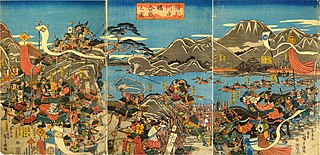
The Battles of Kawanakajima were a series of battles fought in the Sengoku period of Japan between Takeda Shingen of Kai Province and Uesugi Kenshin of Echigo Province from 1553 to 1564.

The Battle of Mikatagahara was a battle of the Sengoku period of Japan fought between Takeda Shingen and Tokugawa Ieyasu in Mikatagahara, Tōtōmi Province on 25 January 1573.
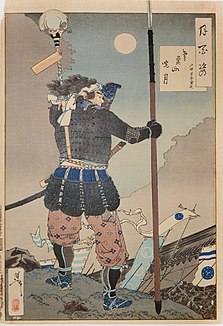
The Battle of Nagashino took place in 1575 near Nagashino Castle on the plain of Shitarabara in the Mikawa Province of Japan. Takeda Katsuyori attacked the castle when Okudaira Sadamasa rejoined the Tokugawa, and when his original plot with Oga Yashiro for taking Okazaki Castle, the capital of Mikawa, was discovered.

Nagashino Castle was a Sengoku period Japanese castle located in what is now Shinshiro, eastern Aichi Prefecture, Japan. It is noteworthy as the site of the crucial Battle of Nagashino between the combined forces of Tokugawa Ieyasu and Oda Nobunaga against Takeda Katsuyori in 1575. The site has been protected by the central government as a National Historic Site since 1929, the first time a former castle site had received such protection.
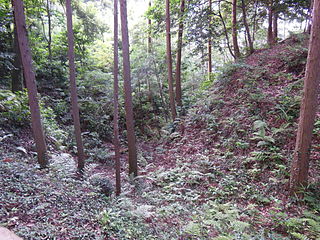
Noda Castle was a Sengoku period castle located in eastern Mikawa Province in what is today part of the city of Shinshiro, Aichi Prefecture, Japan.

The Siege of Noda Castle (野田城の戦い) took place from January to February 1573, between the forces of the Takeda clan, led by the noted warlord Takeda Shingen, against the Tokugawa clan, led by Tokugawa Ieyasu. Along with the Battle of Mikatagahara it was one of the final battles in Takeda Shingen's long career.
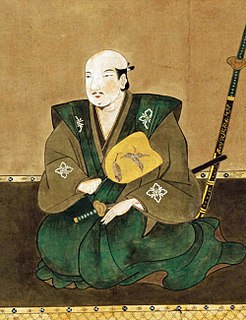
Takeda Katsuyori was a Japanese daimyō of the Sengoku period,who was famed as the head of the Takeda clan and the successor to the legendary warlord Takeda Shingen.
Imagawa Ujizane was a Japanese daimyō who lived in the Sengoku through early Edo periods. He was the tenth head of the Imagawa clan, and was a son of Imagawa Yoshimoto and the father of Imagawa Norimochi and Shinagawa Takahisa.

The Twenty-Four Generals were just one of many historically famous groupings of battle commanders from Japan's Sengoku Period. These Twenty-Four were the most trusted companions of Takeda Shingen. A third of them died at the famous Battle of Nagashino in 1575 when they led the Takeda forces against Oda Nobunaga. When Takeda Katsuyori committed suicide in 1582, declaring the end of the Takeda clan, only three of them were still serving under the Takeda.
Ankokuji Ekei was a descendant of the Takeda clan of Aki province. Although it is certain that he was from the Aki Takeda clan, there are various theories about his birth year and father, and the former is said to have been in 1537 or 1539. There are two theories about the father : one says that Takeda Nobushige was his father, and the other says that Takeda Shigekiyo (†1541), the father of Nobushige, was his father. In 1541, when the Aki Takeda were destroyed by Mori Motonari, he was taken away by faithful vassals and put in a safe place in Ankokuji Temple in Aki Province.
Suwa Yorishige (諏訪頼重) (1516–1544) was a Japanese samurai and head of the Suwa clan. He was defeated by Takeda Shingen, and his daughter Suwa Goryōnin was taken as Shingen's concubine. She later gave birth to the Takeda clan heir Takeda Katsuyori.
The Battle of Takatenjin (高天神の戦い) was fought in 1574 between the forces of Tokugawa Ieyasu and the forces of Takeda Katsuyori.
The second siege of Takatenjin came only six years after Takeda Katsuyori took the fortress.
Takatenjin Castle, in the south of Japan's old Tōtōmi Province, came under siege twice in the 16th century.
The 1575 Siege of Yoshida Castle was undertaken by Takeda Katsuyori against the forces of Tokugawa Ieyasu during the Sengoku Period of Japanese history. This would be one of many battles fought by the Tokugawa and Takeda samurai clans during Japan's Sengoku period (1467-1603).
The 1580 battle of Omosu was one of many battles fought between the Hōjō and Takeda clans during Japan's Sengoku period. It is distinguished, however, as one of the very few naval battles to be fought in pre-modern Japan.
The 1582 siege of Takatō (高遠城の戦い) was one of the final battles of the Takeda clan against the forces of Oda Nobunaga and Tokugawa Ieyasu.

Minowa Castle is a castle located in Takasaki, Gunma Prefecture, Japan.

Takatenjin Castle was a Sengoku period yamashiro-style Japanese castle located in what is now part of the city of Kakegawa, Shizuoka prefecture. The site has been protected by the central government as a National Historic Site since 1975.
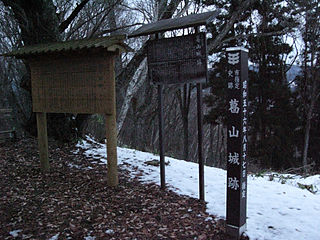
The Siege of Katsurayama in March 1557 was fought between the forces of the Japanese daimyō Takeda Shingen and Uesugi Kenshin as part of the Kawanakajima campaigns. Katsurayama castle was a strategically vital Uesugi stronghold in the contested Shinano Province and, when it was isolated from reinforcements due to late snow in early 1557, the Takeda clan used this opportunity to attack it. Although the castle garrison, consisting of the Ochiai clan and elements of the Murakami clan, defended Katsurayama furiously, the Takeda forces under Baba Nobuharu eventually stormed into the castle. Most of the garrison was killed in combat, while the families of the defenders committed mass suicide and the castle was burned to the ground.










